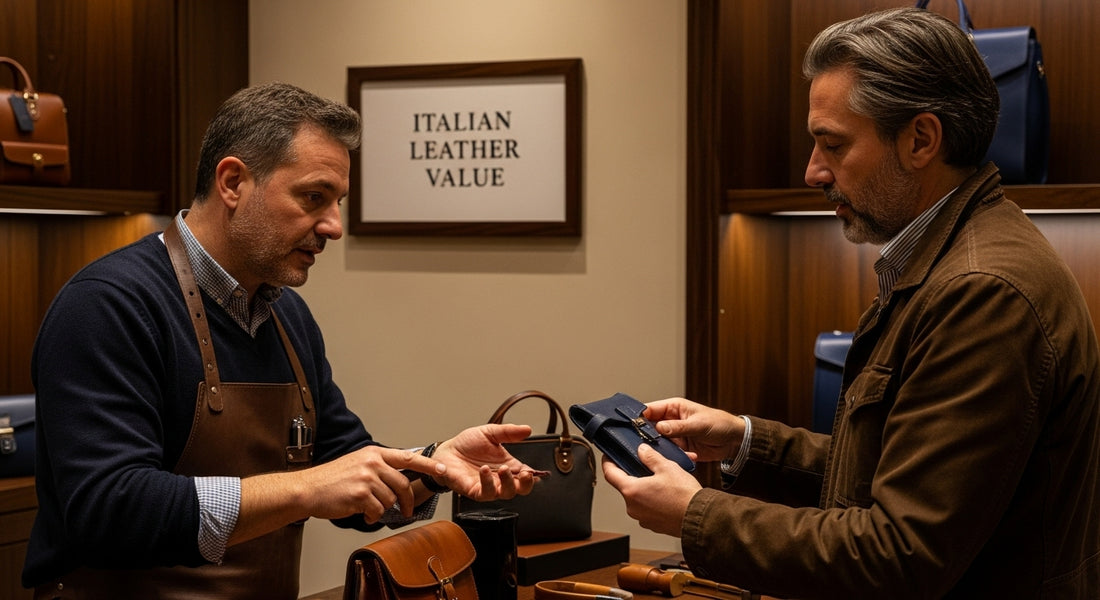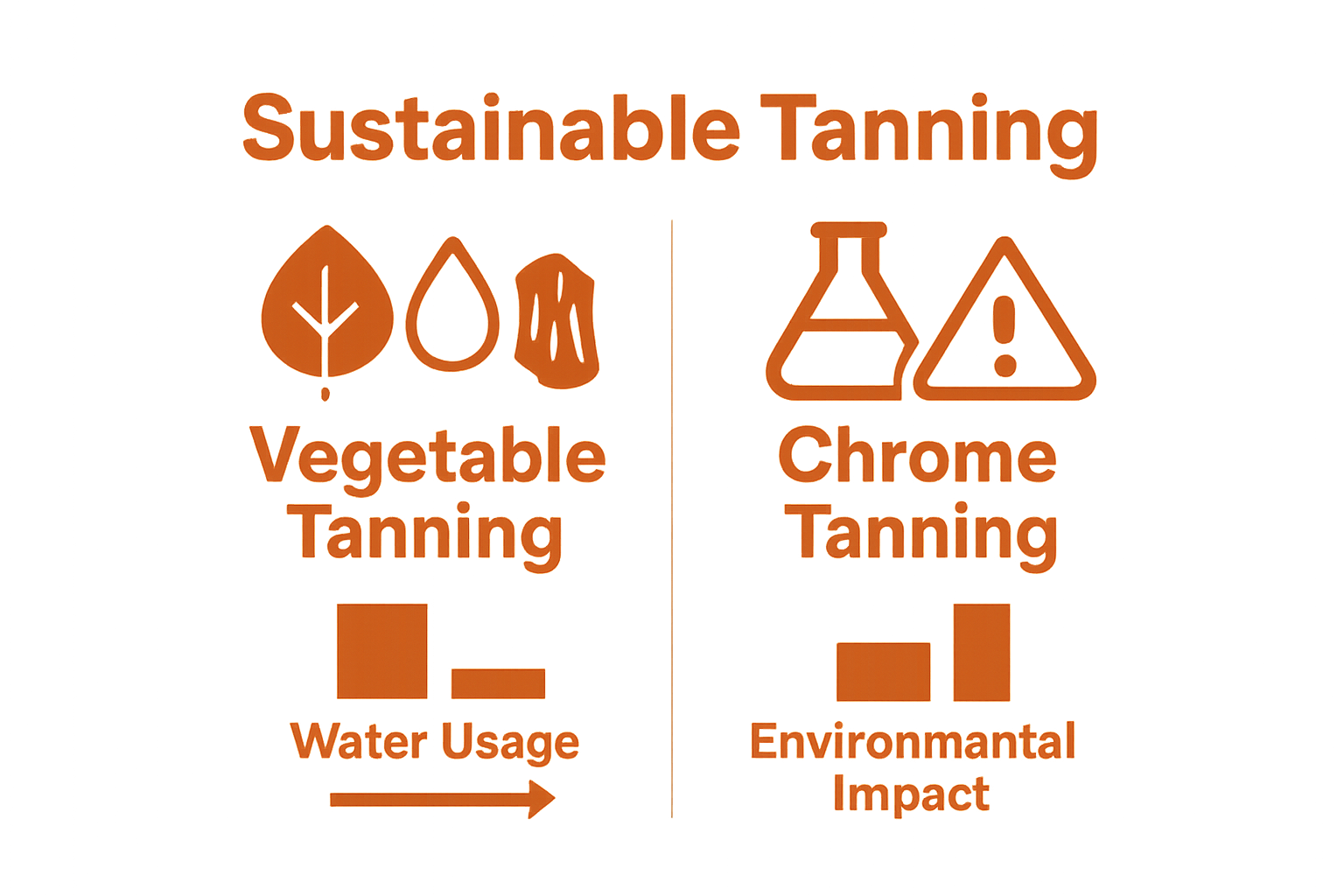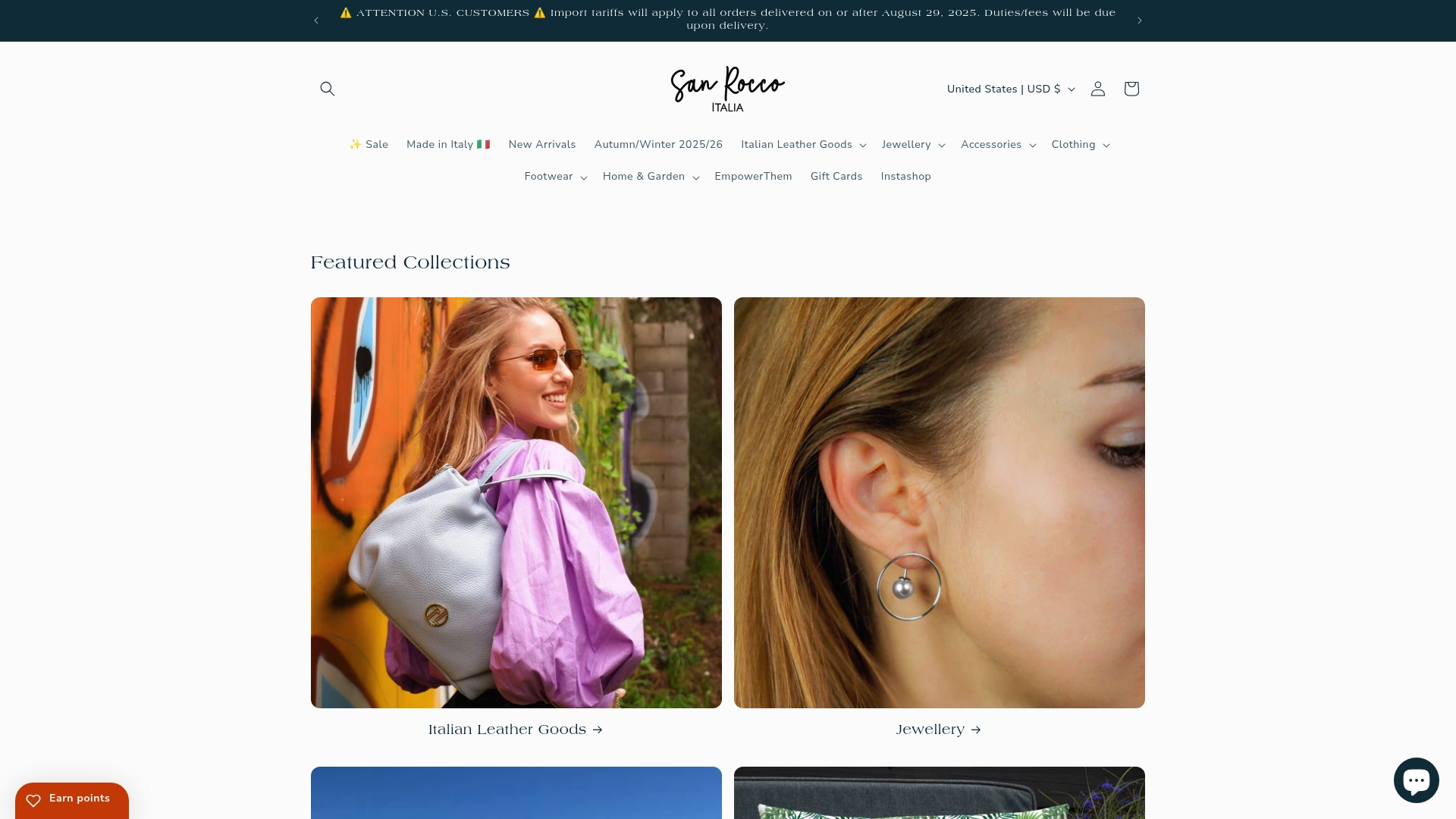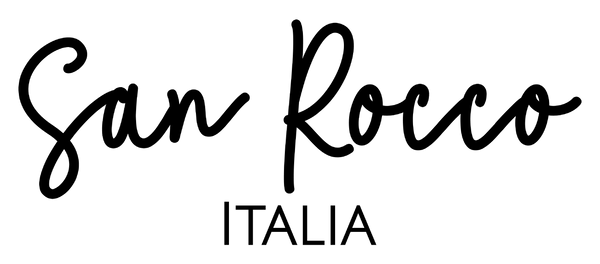
Why Invest in Italian Leather: Understanding its Value
Share
Italian leather holds a reputation for luxury that echoes around the world, and its name alone commands respect among designers and collectors. Most people are surprised to learn that Italian leather products account for roughly 23 percent of the global luxury leather market. That dominance is not just about old traditions or fancy labels. It comes down to fiercely protected craftsmanship and sustainability practices that set Italian leather far above the rest.
Table of Contents
- The Unique Qualities Of Italian Leather
- The Heritage And Craftsmanship Behind Italian Leather
- Sustainability And Eco-Friendliness In Italian Leather Production
- The Value Proposition: Durability And Timelessness
- Why Italian Leather Is A Smart Investment
Quick Summary
| Takeaway | Explanation |
|---|---|
| Invest in Italian leather for heritage and quality | Acquiring Italian leather means gaining a piece of exceptional craftsmanship with a rich cultural history. |
| Choose vegetable-tanned leather for sustainability | This method utilises natural materials, reducing environmental impact while preserving leather quality and durability. |
| Expect durability and timelessness in Italian leather | Superior raw material selection and skilled craftsmanship ensure that Italian leather lasts and ages beautifully over time. |
| Recognise the financial value of Italian leather | Items made from Italian leather can appreciate over time due to their craftsmanship and limited production, making them wise investments. |
| Appreciate the artisanal story behind each piece | Each Italian leather item carries generational knowledge, adding emotional and cultural significance to your purchase. |
The Unique Qualities of Italian Leather
Italian leather represents the pinnacle of craftsmanship, distinguished by extraordinary qualities that set it apart from leather produced in other regions.
To clarify the distinctions between Italian leather and mass-produced or conventional leathers, the following table summarises the key differences mentioned in the article.
| Aspect | Italian Leather | Conventional/Mass-Produced Leather |
|---|---|---|
| Raw Material Selection | Premium full-grain hides from carefully bred cattle | Variable quality, often lower grade hides |
| Tanning Process | Traditional vegetable tanning using natural extracts | Often uses chemical (chrome) tanning |
| Craftsmanship | Artisanal, generational knowledge, meticulous control | Industrial, large-scale, machine-driven |
| Sustainability | Emphasis on eco-friendly processes, waste reduction | May lack commitment to sustainability |
| Durability & Ageing | Highly durable, develops unique patina | May deteriorate or fade more quickly |
Superior Raw Material Selection
The exceptional quality of Italian leather begins with meticulously selected raw materials. Italian tanneries prioritise using premium full-grain leather sourced from carefully bred cattle, ensuring each hide possesses remarkable durability and natural aesthetic appeal. Research from the Italian Leather Council reveals that over 80% of Italian leather producers maintain strict standards in hide selection, focusing on minimal imperfections and optimal texture.
Italian artisans understand that superior leather starts with superior animal husbandry. They work closely with local farmers who raise cattle in controlled environments, minimising stress and maintaining high animal welfare standards. This approach directly impacts leather quality, resulting in more supple, resilient materials.
Traditional Tanning and Finishing Techniques
What truly distinguishes Italian leather is its extraordinary tanning process. Unlike mass-production methods, Italian tanneries employ centuries-old techniques passed through generations. Historical research from Consorzio Vera Pelle Italiana Conciaria demonstrates that these traditional methods involve complex vegetable tanning processes using natural extracts from tree bark, creating leather with unparalleled character and longevity.
Key characteristics of Italian leather tanning include:
- Slower, more intentional processing times
- Natural vegetable tannins instead of harsh chemicals
- Preservation of leather’s original grain and texture
- Enhanced breathability and aging characteristics
These techniques ensure that Italian leather develops a rich patina over time, becoming more beautiful with each use. For more insights, our guide on understanding Italian leather craftsmanship provides deeper exploration of these remarkable techniques.
Environmental and Ethical Considerations
Beyond aesthetic and durability, Italian leather production increasingly emphasises sustainability. Modern Italian tanneries are implementing eco-friendly practices, reducing water consumption and chemical usage while maintaining exceptional quality standards. This commitment reflects a broader understanding that luxury and environmental responsibility can coexist harmoniously.
The Heritage and Craftsmanship Behind Italian Leather
Italian leather craftsmanship represents more than a manufacturing process it embodies a profound cultural legacy spanning centuries of artistic and technical expertise. This extraordinary tradition transforms leather from a mere material into a symbol of exceptional quality and aesthetic refinement.
Historical Origins of Italian Leather Mastery
The roots of Italian leather craftsmanship trace back to medieval Florence and Venice, where guilds of skilled artisans developed intricate techniques that would become global benchmarks. Research from the Italian Leather Research Institute reveals that these craftsmen established rigorous training protocols, ensuring knowledge was meticulously transmitted across generations.
Key historical milestones in Italian leather development include:
- 13th-century Florentine leather guilds establishing professional standards
- Renaissance period refinement of tanning and decorative techniques
- Emergence of specialised leather districts like Santa Croce sull’Arno
These historical foundations created a sophisticated ecosystem of leather production that prioritised skill, innovation, and uncompromising quality.
Artisanal Training and Generational Knowledge
What distinguishes Italian leather craftsmanship is its profound commitment to apprenticeship and personal mentorship. Young artisans do not merely learn technical skills they absorb a holistic philosophy of design and quality. According to the Italian Chamber of Commerce, many leather workshops remain family-owned enterprises where techniques are passed directly from parent to child.
This generational transfer ensures that each piece of leather carries not just technical excellence but emotional and cultural significance. The artisan’s touch transforms raw material into a narrative of skill, patience, and artistic vision.
Global Recognition and Contemporary Relevance
Modern Italian leather continues to command global respect, with research from the World Leather Association indicating that Italian leather products represent approximately 23% of the global luxury leather market. Contemporary Italian leather artisans are not simply preserving tradition they are innovating, integrating sustainable practices and cutting-edge design while maintaining their core commitment to exceptional craftsmanship.
Discover more about why Italian craftsmanship remains unparalleled in our comprehensive guide and explore how this rich heritage continues to shape global luxury standards.
Sustainability and Eco-Friendliness in Italian Leather Production
Italian leather production is experiencing a transformative shift towards sustainability, reimagining traditional manufacturing processes through an environmentally conscious lens. This evolution represents a profound commitment to reducing ecological impact while maintaining the exceptional quality that Italian leather is renowned for worldwide.
The next table provides a concise overview of the main sustainability features found in modern Italian leather production as detailed in the article.
| Sustainability Feature | Description |
|---|---|
| Vegetable Tanning | Uses natural plant-based tannins, reduces chemical pollution |
| Waste Reduction | Recycling of leather scraps, water reuse, energy efficiency |
| Renewable Energy | Adoption of renewable energy sources in manufacturing |
| Certification | Pursuit of international environmental and ethical standards |
| Minimal Water Contamination | Processes designed to limit water pollution |
| Enhanced Product Durability | Longer lifespan reduces overall ecological impact |
Vegetable Tanning: A Natural Approach
Vegetable tanning emerges as a cornerstone of sustainable Italian leather production.
Unlike conventional chrome tanning methods, this traditional technique utilises natural tannins extracted from tree bark, roots, and plant materials. Research from the Tuscan Leather District demonstrates that vegetable tanning significantly reduces chemical pollution and creates leather with remarkable environmental credentials.
Key advantages of vegetable tanning include:

- Biodegradable processing chemicals
- Minimal water contamination
- Preservation of natural leather characteristics
- Enhanced leather durability and aging properties
Circular Economy and Waste Reduction
Modern Italian leather manufacturers are pioneering circular economy principles, transforming waste into valuable resources. Advanced recycling techniques enable tanneries to repurpose leather scraps, minimise water consumption, and develop innovative production methods that dramatically reduce environmental footprint.
Waste reduction strategies implemented by leading Italian tanneries include:
- Leather scrap recycling into secondary products
- Water filtration and reuse systems
- Energy-efficient manufacturing processes
- Utilisation of renewable energy sources
Certification and Ethical Production
Transparency and accountability have become fundamental to sustainable Italian leather production. Manufacturers are increasingly pursuing rigorous international certifications that validate their environmental and ethical standards. According to the Global Leather Compliance Initiative, certifications like the Leather Working Group Gold Rating represent a comprehensive assessment of environmental management, social responsibility, and chemical usage.
Explore the future of sustainable Italian leather production in our comprehensive industry insights guide and understand how innovation is reshaping this traditional craft.
The Value Proposition: Durability and Timelessness
Italian leather transcends conventional material qualities, offering an extraordinary value proposition built on exceptional durability and inherent timelessness. Unlike mass-produced leather goods that deteriorate quickly, Italian leather represents an investment in enduring elegance and superior craftsmanship.
Material Resilience and Long-Term Performance
Durability begins with exceptional raw material selection. Research from textile experts reveals that Italian leather’s remarkable longevity stems from meticulous hide selection and sophisticated tanning techniques. Full-grain leather, characteristically used in premium Italian production, maintains structural integrity far beyond conventional leather products.
Key indicators of Italian leather’s exceptional durability include:
- Resistance to wear and tear
- Natural ability to repel moisture
- Minimal degradation under regular use
- Enhanced structural stability over time
When properly maintained, Italian leather products can endure decades, often becoming more aesthetically appealing as they age. This characteristic transforms leather from a mere accessory to a generational heirloom, representing genuine long-term value.

Aesthetic Aging and Patina Development
Unlike synthetic materials that deteriorate, Italian leather develops a beautiful patina that tells a unique story. Each item gradually acquires subtle colour variations and soft texture modifications, reflecting its personal journey and usage history. This natural aging process elevates Italian leather from a functional material to a living, evolving artifact.
The patina development process demonstrates Italian leather’s exceptional quality by:
- Maintaining structural integrity
- Creating unique visual character
- Enhancing aesthetic appeal with age
- Reflecting individual usage patterns
Investment Value and Economic Perspective
From an economic standpoint, Italian leather represents a strategic investment. Luxury market analysis indicates that well-crafted leather goods retain significant monetary value, with premium Italian leather items often appreciating over time. The combination of exceptional craftsmanship, limited production, and timeless design creates a compelling economic narrative.
Discover more about the intrinsic value of Italian leather craftsmanship in our comprehensive handbag guide and explore why discerning consumers continue to choose these remarkable products.
Why Italian Leather is a Smart Investment
Investing in Italian leather represents a sophisticated approach to acquiring luxury goods that transcend mere aesthetic appeal, offering substantial long-term financial and personal value. This investment strategy combines cultural heritage, exceptional craftsmanship, and economic intelligence.
Appreciating Asset Value
Italian leather goods are not conventional purchases but strategic investments with potential appreciation. According to the US Embassy’s economic analysis, the global reputation of Italian leather ensures sustained market demand, creating a unique economic proposition where quality directly correlates with monetary value.
Key factors contributing to investment potential include:
- Limited production quantities
- Exceptional craftsmanship
- Global luxury market recognition
- Consistent design and quality standards
- Historical brand reputation
Discerning investors understand that authentic Italian leather items represent more than consumable products they are tangible assets with intrinsic economic value that can potentially appreciate over time.
Quality as Economic Leverage
The exceptional quality of Italian leather creates a robust economic ecosystem. By maintaining rigorous production standards, Italian manufacturers ensure that their products retain significant market value. Handcrafted precision becomes a financial instrument, transforming leather goods from mere accessories into strategic wealth preservation mechanisms.
Significant quality indicators that enhance investment potential:
- Superior raw material selection
- Meticulous artisanal techniques
- Minimal production volumes
- Extensive quality control processes
- International luxury market recognition
Cultural and Emotional Investment
Beyond financial considerations, Italian leather represents an investment in cultural heritage and personal expression. Each piece embodies generations of craftsmanship, telling a story that extends far beyond its immediate material value. The emotional connection and cultural significance add intangible dimensions to the investment, creating a profound sense of ownership and appreciation.
Explore our comprehensive guide to understanding the deeper value of Italian craftsmanship and discover why intelligent investors choose Italian leather as a sophisticated asset.
Invest in Timeless Italian Craftsmanship with San Rocco Italia
If you have been searching for luxury that truly lasts, your journey through the value of Italian leather in this article has already uncovered the pain points many face today. Mass-produced goods lose their elegance and value quickly, but you deserve accessories that grow richer and more beautiful as years pass. The key strength described above—exceptional durability, craftsmanship, and authentic heritage—can be found in every item curated by San Rocco Italia. Every handbag and leather piece we offer embodies centuries-old Italian artistry, supported by modern sustainability and a promise of long-term worth.

Are you ready to own a piece that tells your story? Visit San Rocco Italia to discover our exclusive collection of Italian leather handbags and accessories, meticulously made by artisans using only the finest full-grain leather. If you want to learn more about what makes our selection unique, explore our detailed guide on the benefits of Italian handbags. Do not settle for less when you can invest in the beauty and confidence of genuine Italian mastery. Shop today and experience true timelessness.
Frequently Asked Questions
What makes Italian leather different from other types of leather?
Italian leather is distinguished by its superior raw material selection, traditional tanning methods, and meticulous craftsmanship. It often uses premium full-grain leather and vegetable tanning techniques, which enhance durability and create unique aesthetic qualities.
How does the durability of Italian leather compare to other materials?
Italian leather is highly durable due to meticulous hide selection and sophisticated tanning processes. Its structural integrity and ability to develop a beautiful patina over time make it more resilient than many other leather types, often lasting decades with proper care.
What are the environmental benefits of choosing Italian leather?
Italian leather production increasingly employs sustainable practices, particularly vegetable tanning, which uses natural materials and reduces chemical pollution. Many tanneries focus on recycling waste and minimising water consumption, aligning luxury with environmental responsibility.
Is Italian leather a good investment?
Yes, Italian leather is considered a smart investment due to its potential for appreciation in value. Its combination of exceptional craftsmanship, limited production, and strong demand in the luxury market enhances its monetary value over time.
Recommended
- Understanding Italian Leather Craftsmanship: Timeless Quality – San Rocco Italia
- Understanding the Benefits of Italian Handbags – San Rocco Italia
- The Future of the Italian Leather Industry: Trends & Insights – San Rocco Italia
- Understanding Vegetable Tanned Leather Patina: Beauty Unveiled – San Rocco Italia


